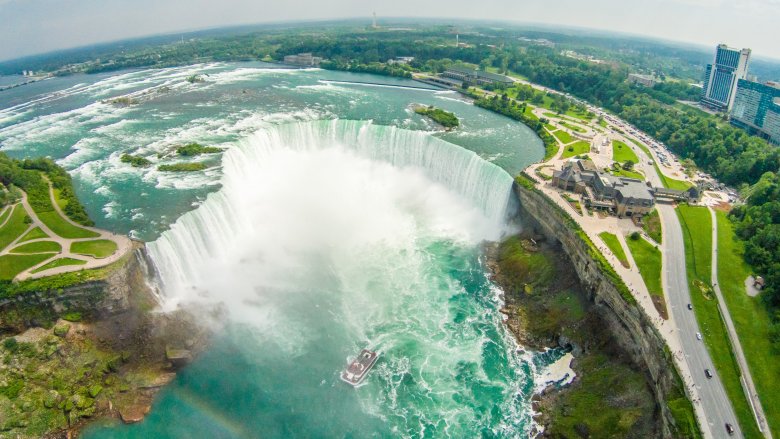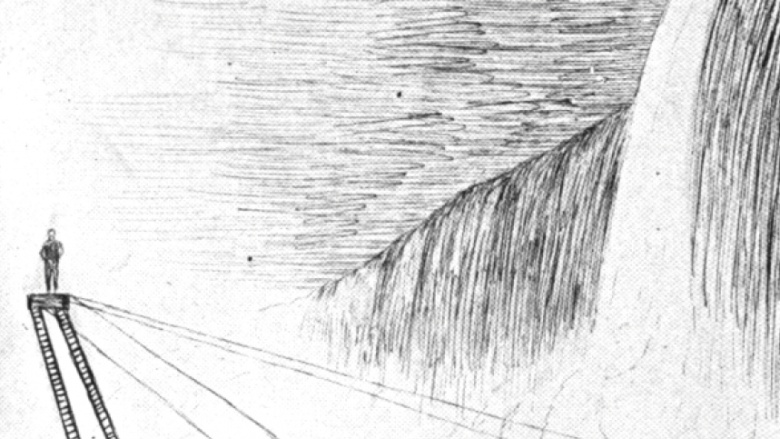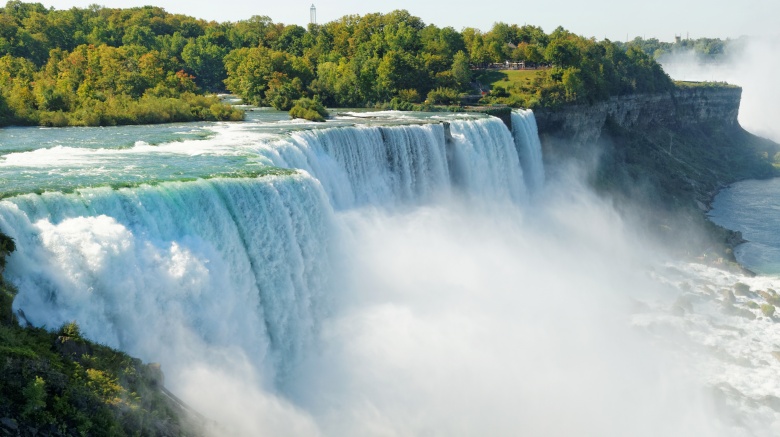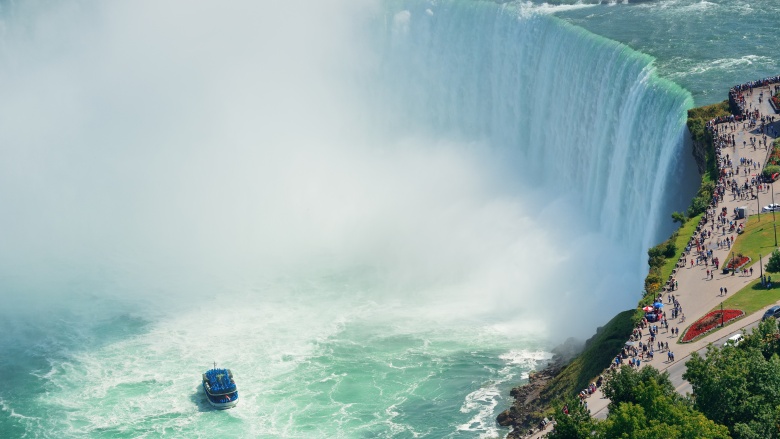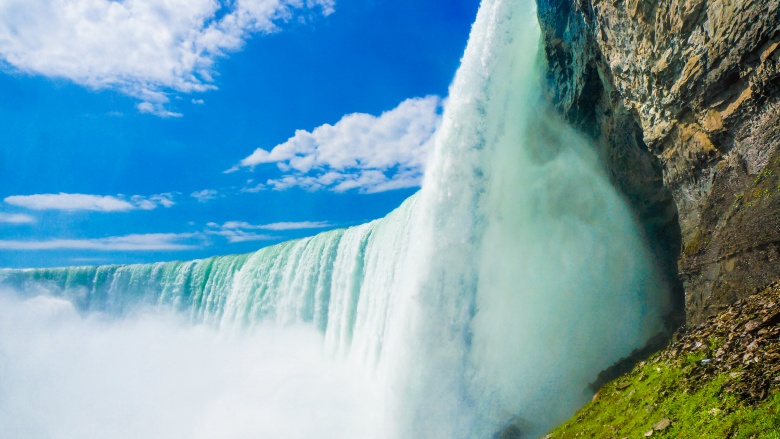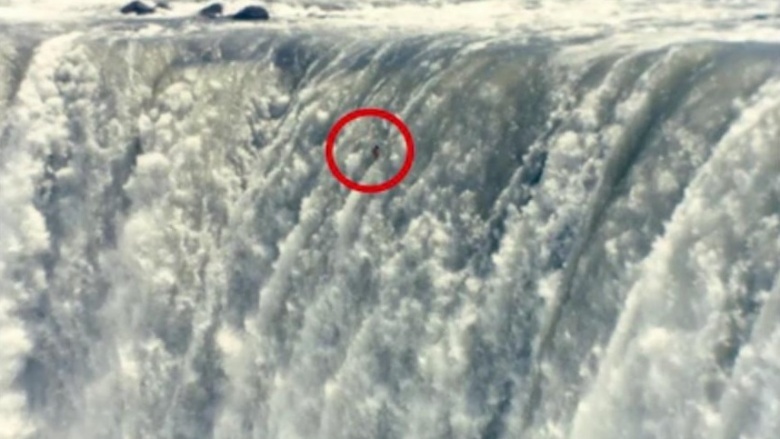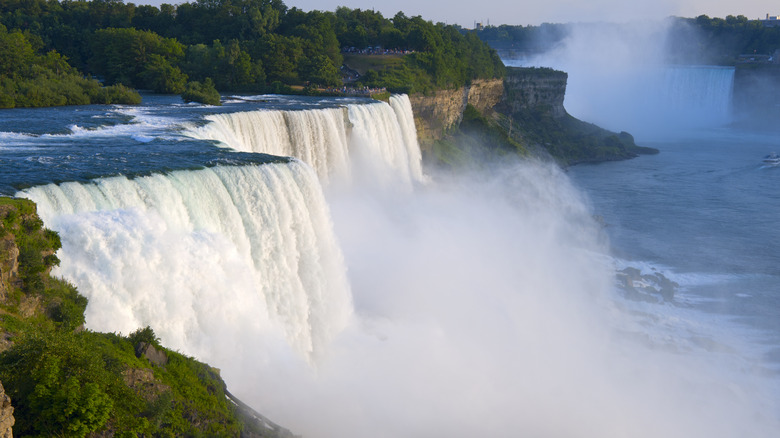The Tragic History Of People At Niagara Falls
Niagara Falls attracts millions of visitors every year, who all come to gaze upon an astonishing natural wonder. But while most people who visit are content to stand back and watch, or maybe take a ride on the Maid of the Mist, there are some who need to take it a step further. But while most of the people who die at Niagara are sadly trying to commit suicide, every now and then someone takes a fatal plunge over the edge despite having every intention of celebrating their next birthday.
Sam Patch (1829)
If we were to just tell you the story of Sam Patch and show you a few of the promotional posters he used to drum up publicity, you might think he was some folk hero like Johnny Appleseed. Hell, even his name sounds like something out of an old yarn passed down by your great grandpappy. But in truth, he was a "waterfall jumper," which was apparently a thing at one point in time. There are two unfortunate happenstances we're about to toss at you. Unfortunately, being a "waterfall jumper" isn't quite as cool as it sounds. And unfortunately, while Sam Patch was pretty good at it, it turns out that the actual jumping is the easy part. It's the "surviving the fall" that gets tough.
You might think a waterfall jumper leaps across the entire expanse of a waterfall, what Patch actually would do is set up a platform and dive off into the bottom of the falls. He successfully pulled this off once at Niagara Falls, but like any huge success, he decided it needed a bigger-budget sequel. And like many sequels, it was a crappy follow-up. On November 13, 1929, Patch leaped from 125 feet off nearby Genesee Falls — in an event sadly and ironically billed as "Patch's last jump" during the publicity phase — and disappeared into the bottom of the falls, never to be seen alive again. Patch's body was found four months later and 7 miles down the Genesee River.
Big Ed Delahanty (1903)
Ed Delahanty was a Major League Baseball player, and a pretty good one, too—he still sits fifth on the list of all-time best batting averages. However, it all came to an end in 1903, via somewhat bizarre circumstances when he got drunk on a train. Travelling back to New York from Detroit, Delahanty reportedly drank five shots of whiskey before getting disorderly and threatening passengers. As they were passing the falls, but still on the Canadian side, the conductor stopped the train and kicked Delahanty off. In an effort to get back to the American side, Delahanty tried to cross the International Falls bridge, but after a confrontation with a night watchman, he ended up in the river and was swept over the falls. It remains unknown to this day whether he jumped or fell by accident, but either way it was an ignominious end to an impressive career. His body was recovered a week later by the captain of the Maid of the Mist, forever answering the question of whether Big Ed Delahanty would rather burn out, or wash away.
Charles Stephens (1920)
Despite what internet commenters might lead you to believe, sometimes being the "first" of something isn't all it's cracked up to be. Just ask Charles Stephens. Well, you could ask him if he weren't dead. He was born in 1862, and he'd probably say that being the answer to a trivia question isn't very fun when the question is, "Who was the first daredevil to die going over Niagara Falls?"
Stephens was a poor barber and father of 11, and he decided to take the splash for noble causes: he wanted to try and better provide for his family. We won't begrudge him that, certainly, though we have to question his methods. For starters, Stephens strapped himself tightly inside the barrel. Not necessarily a bad idea, all things considered, unless you take into account the fact that he also tied an anvil to his feet for some reason. Barber college must not teach much about physics, or the fact that a big, heavy anvil is the last thing you want strapped to you when you're plunging into a violent torrent of water. Stephens' body was destroyed upon impact. The only piece of him ever found was one arm. But hey, at least it was still strapped firmly in place inside the barrel. He may not have been too smart, but at least he knew how to fasten a harness.
George Stathakis (1930)
George Stathakis was a Greek immigrant who worked as a chef in New York city, though he had dreams of publishing a book. It was with this in mind that he made plans to float himself over the Falls, hoping that any fame and fortune he acquired would allow him to get his book out into the world, but it was not to be. With the help of his friends, he constructed for himself a massive barrel that measured ten feet long by five feet wide. It was the largest and heaviest barrel ever constructed for the task, and in the end it probably killed him. On July 5th, 1930, Stathakis took his lucky pet turtle and bolted himself inside his air-tight contraption. However when he slipped over the edge of the Falls, instead of bobbing back to the surface, his barrel became lodged behind the Falls, and there he remained for over eighteen hours. When the barrel was eventually recovered, it appeared almost entirely unscathed, but when the hatch was opened George was dead, having run out of air and suffocated long before. As it turned out, the turtle was indeed lucky because, unlike his owner, he came out of the adventure completely unharmed.
William Red Hill (1951)
William "Red" Hill's decision to take a ride over Niagara Falls is somewhat mysterious, considering his father had made a habit of plucking people out of the river. Nevertheless, Red Hill Jr. decided to make the attempt and set about building his "vessel." He had previously ridden a barrel through the rapids below the falls, but when it came to the big drop, he lacked the funds to do anything more significant than strap a bunch of inner tubes together with a fishing net and christen it "The Thing." But the thing about "The Thing" was, it was a completely inappropriate and under-built contraption for free-falling over 165 feet into a chaotic maelstrom ... and unsurprisingly, when the tattered remnants of "The Thing" reappeared, Red Hill Jr. was nowhere to be seen. The battered body was recovered the next day, and from then on it became illegal to attempt to ride over the falls.
James Honeycutt (1960)
Fair warning: we're getting into the legitimately sad stuff now. Not that there's anything funny about anyone's deaths, but some of them knew what they were getting into and the chances they were taking. Now, we're talking about regular people whose lives were tragically and shockingly ripped away from them. Like James Honeycutt, whose death was overshadowed by the fact that he died amid a fairly miraculous rescue of a small boy. The story everyone hears is about 7-year-old Roger Woodward, who dropped 162 feet after a boating accident on the river leading to Niagara Falls.
Woodward and his 17-year-old sister were on a small boat owned by Honeycutt, a family friend, on July 9, 1960. Woodward's sister, Deanne, was rescued before the group reached the falls. Roger Woodward and James Honeycutt were not so fortunate. As we mentioned, little Roger miraculously survived the fall, and his survival became the big story. Somehow he emerged from the crushing water at the base of the falls and was pulled safely aboard the Maid in the Mist. Sadly, though, Honeycutt perished and became simply a footnote to an incredible story.
Hesham Sayegh (1981)
Unfortunately, we're going to follow Roger Woodward being saved with an even smaller child being killed. In the late summer of 1981, 28-year-old Dunia Sayegh was visiting the Canadian Horseshoe Falls with her 2-month-old son, Hesham, in her arms. You can already see where this one is going, but it takes an even darker twist. Yes, we're very sad to say that little Hesham slipped from his mother's arms and plunged to his death over Niagara Falls.
But then the young mother was brought to trial, suspected of intentionally throwing her infant to his demise. Dunia claimed to have suffered from a dizzy spell and said she simply dropped her young son. Why she was standing so close to the railing while holding him is another matter entirely, but the presiding judge eventually dismissed a charge of manslaughter and set her free. Considering her friends claimed that she lived for her new baby and had previously worried about his health to the point that her doctor had to prescribe her medication to help her relax, losing him to Niagara Falls certainly seems like far more punishment than she probably deserved.
Jessie Sharp (1990)
Jessie Sharp was 28 years old when he made his attempt on the Falls in 1990, and he wouldn't get any older. Being an accomplished whitewater kayaker, he understandably made the decision to stick with what he knew and paddle his way through in a canoe, but some of his other decisions were less understandable. He brought with him several friends to record the event, and to make sure his face was visible in the video, he elected not to wear a helmet. He also chose not to wear a lifejacket, thinking it would hinder his escape should he get into trouble at the bottom. Of course, that's assuming he's conscious down there — if not, then a lifejacket would have come in real handy. Jessie was so confident of making the jump, he made dinner reservations for that evening further down river. Unfortunately, despite his intention to land beyond the turbulent water at the base of the Falls, he disappeared into it. And although his kayak later washed ashore with hardly a scratch on it, his body was never recovered.
Robert Overacker (1995)
Robert Overacker made probably the ballsiest-ever attempt at riding the Falls in 1995, but his goals were rather more charitable than personal fame. Intending to raise awareness of the homeless, Overacker (a trained stuntman) rode a jet ski at full-speed straight off the horseshoe falls. His intention had been to activate a rocket-propelled parachute as he went over, and ride safely down to the bottom, but the parachute failed to deploy properly and he made the 180-foot descent a lot faster than he was expecting. Despite appearing to be swimming as he floated away, according to police, he probably died on impact. His body was quickly recovered by the crew of the Maid of the Mist, but despite efforts to resuscitate him, he was officially pronounced dead on arrival at the hospital.
Overacker was the fifteenth person to deliberately attempt to ride over Niagara Falls, and the fifth to die doing it since 1901. Let's hope he's the last, on both counts.
Ayano Tokumasu (2011)
Just like in the case of Dunia and Hesham Sayegh, it can be a little tough sometimes to determine who goes over Niagara Falls with intent and whose tragic plunge is purely accidental. In the case of Ayano Tokumasu, it may have initially looked to some like an intentional dive but it turns out, it was just a dumb, completely avoidable accident. There's a stern lesson in the fact that sometimes you should probably go ahead and just stop trying to get the perfect photograph. Tokumasu was apparently climbing on and climbing over the rails above Horseshoe Falls, when she slipped, lost her footing, and fell to her death.
And she was climbing, of course, because she wanted a great picture. Several folks in the area saw the 20-year-old exchange student clambering up onto the rock and metal posts and railings. Her friends had always described her as adventurous, but reckless probably wasn't a good addition. It's a tragic loss, no doubt. But it's one that could have easily been prevented. Follow the rules, keep your arms and hands inside the ride, and for Pete's sake ... don't climb out onto the edge of a wet and slippery chasm of watery death. You're just asking for trouble.
The brave animals of the schooner Michigan (1827)
Maybe a good way to cleanse our collective palate of dark and depressing human deaths is with one of the most ridiculous Niagara Falls stories imaginable. Settle in for the story of the schooner Michigan.
In 1827, a hotel owner named William Forsyth teamed with some of the hotel owners in the Niagara Falls area in an attempt to drum up some business. Like anyone, they wanted to find new and creative ways to generate some buzz and make a little more cash. And like so many businessmen, they settled on what they deemed a brilliant publicity stunt. They had Niagara Falls at their disposal, and everyone likes to watch things crash and burn, right? So clearly, their only course of action would be to purchase a schooner, set it loose with a fairly random selection of local animals aboard, and watch it plunge over the falls.
Thousands of people turned out to watch as the Michigan was set adrift. Two bears had been placed aboard, but they wisely decided to abandon ship, swimming safely to shore before the boat could reach the precipice. Unfortunately, things weren't so rosy for the other animals, including a buffalo, which had been locked in a pen on board with no hopes of escaping. Raccoons, foxes, and geese were also on board. Of all the animals that actually went over Niagara Falls that day as the Michigan fell to its destruction, only the geese survived. It really just hammers home the idea that if some lunatic hotel owner wants to drop you a couple hundred feet over a waterfall, it's a good idea to go ahead and get yourself some wings.
